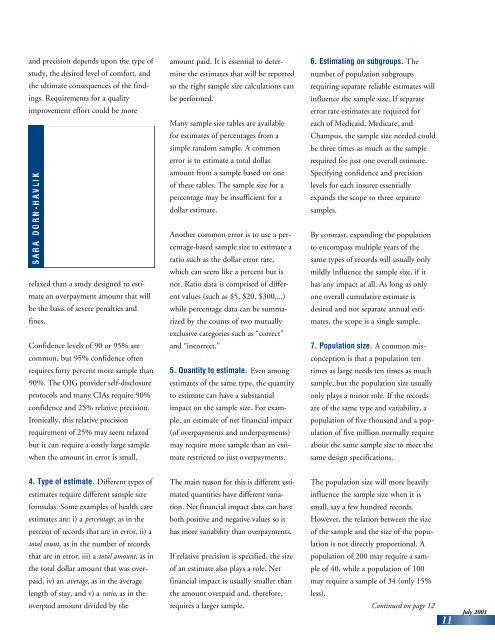SO - Health Care Compliance Association
SO - Health Care Compliance Association
SO - Health Care Compliance Association
You also want an ePaper? Increase the reach of your titles
YUMPU automatically turns print PDFs into web optimized ePapers that Google loves.
and precision depends upon the type ofstudy, the desired level of comfort, andthe ultimate consequences of the findings.Requirements for a qualityimprovement effort could be moreamount paid. It is essential to determinethe estimates that will be reportedso the right sample size calculations canbe performed.Many sample size tables are availablefor estimates of percentages from a6. Estimating on subgroups. Thenumber of population subgroupsrequiring separate reliable estimates willinfluence the sample size. If separateerror rate estimates are required foreach of Medicaid, Medicare, andChampus, the sample size needed couldsimple random sample. A commonerror is to estimate a total dollaramount from a sample based on oneof these tables. The sample size for apercentage may be insufficient for abe three times as much as the samplerequired for just one overall estimate.Specifying confidence and precisionlevels for each insurer essentiallyexpands the scope to three separatedollar estimate.samples.Another common error is to use a percentage-basedsample size to estimate aBy contrast, expanding the populationto encompass multiple years of theratio such as the dollar error rate,same types of records will usually onlyrelaxed than a study designed to estimatean overpayment amount that willbe the basis of severe penalties andfines.which can seem like a percent but isnot. Ratio data is comprised of differentvalues (such as $5, $20, $300,...)while percentage data can be summarizedby the counts of two mutuallymildly influence the sample size, if ithas any impact at all. As long as onlyone overall cumulative estimate isdesired and not separate annual estimates,the scope is a single sample.exclusive categories such as “correct”Confidence levels of 90 or 95% arecommon, but 95% confidence oftenrequires forty percent more sample than90%. The OIG provider self-disclosureprotocols and many CIAs require 90%confidence and 25% relative precision.Ironically, this relative precisionrequirement of 25% may seem relaxedand “incorrect.”5. Quantity to estimate. Even amongestimates of the same type, the quantityto estimate can have a substantialimpact on the sample size. For example,an estimate of net financial impact(of overpayments and underpayments)7. Population size. A common misconceptionis that a population tentimes as large needs ten times as muchsample, but the population size usuallyonly plays a minor role. If the recordsare of the same type and variability, apopulation of five thousand and a populationof five million normally requirebut it can require a costly large samplemay require more sample than an esti-about the same sample size to meet thewhen the amount in error is small.mate restricted to just overpayments.same design specifications.4. Type of estimate. Different types ofThe main reason for this is different esti-The population size will more heavilyestimates require different sample sizemated quantities have different va r i a-influence the sample size when it isformulas. Some examples of health careestimates are: i) a percentage, as in thetion. Net financial impact data can haveboth positive and negative values so itsmall, say a few hundred records.However, the relation between the sizepercent of records that are in error, ii) ahas more variability than overpayments.of the sample and the size of the popu-total count, as in the number of recordslation is not directly proportional. Athat are in error, iii) a total amount, as inIf relative precision is specified, the sizepopulation of 200 may require a sam-the total dollar amount that was over-of an estimate also plays a role. Netple of 40, while a population of 100paid, iv) an average, as in the averagefinancial impact is usually smaller thanmay require a sample of 34 (only 15%length of stay, and v) a ratio, as in thethe amount overpaid and, therefore,less).overpaid amount divided by therequires a larger sample.Continued on page 1211July 2001
















